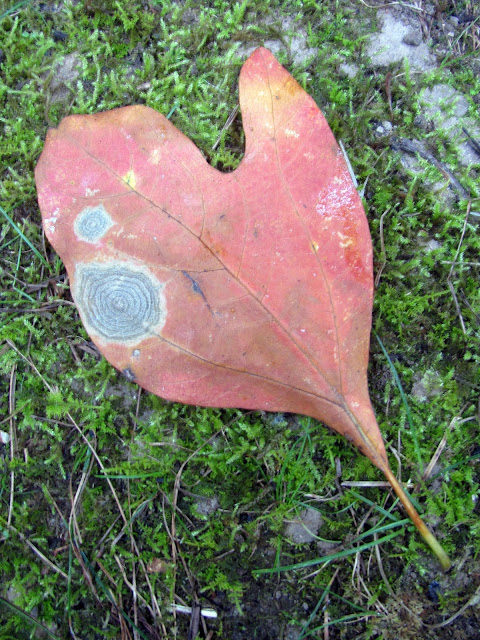on the deeply furrowed
bark of a sassafras tree
a face stares back at me
The day after Labor Day, we're making our annual pilgrimage to the Missouri Ozarks, a pilgrimage that sends me back in time as well as placing me intensely in the present.
Crossing the footbridge to our campsite at Pulltite Campgrounds, I find the fallen leaves of sassafras scattered on the bare ground. If you didn't know, you might think these leaves came from different trees. Some are pointed ovals, others have three "fingers" or lobes, and some look like mittens, both right- and left-handed, with one lobe for the thumb. Why they grow this way on one tree is one of the marvelous mysteries of nature.
In their autumn raiment each leaf is an abstract painting in splashes of green, gold, red and brown, interspersed with dark gray concentric circles like the growth rings of trees. I look around for the source of all these cast offs and find a tall tree, still bearing some green leaves, growing along the little creek that runs under the bridge and into the Current River.
Picking up a red mitten, I press it to my nose. Ah, that sweet scent takes me back to my childhood. My grandmother used sassafras oil as a fragrance for homemade soap. And every year my grandfather dug up roots from trees on their Southern Illinois farm to make sassafras tea. He said the reddish-brown concoction was good for anything that ails you. Even after I went off to college, he would send me a package of the curled bark of the dried roots so I could steep my own tea. And of course, real root beer was always flavored with safrole, the essential oil from steam distilled sassafras roots. (Yes, I know, safrole oil is no longer legal in the US.)
My older sister, when she lived in Louisiana, introduced us to gumbo filé, gumbo made with a powder of dried sassafras leaves, a spicy herb that made its way into Creole cuisine from Native American tribes. In addition to the culinary use of sassafras, Native Americans also used sassafras medicinally, as the oil in all parts of the tree has antiseptic and analgesic properties.
The oil also makes a good insect repellent, and since we're besieged by mosquitoes this close to the river I rub some of the redolent leaves on my bare skin. Then I gather a handful of the leaves, which will make excellent fire starters.





No comments:
Post a Comment